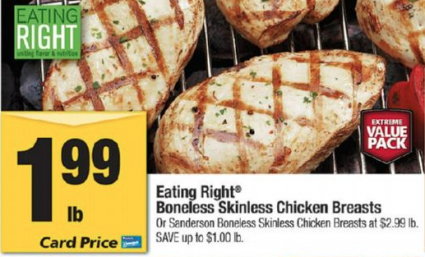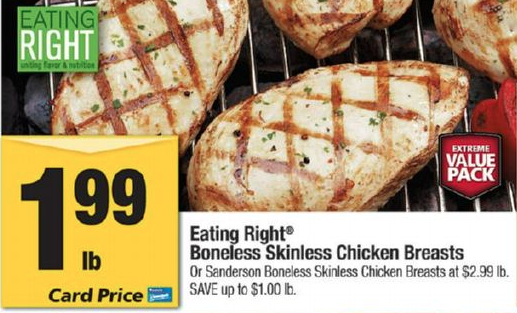In Meat Wagon, we round up the latest outrages from the meat and livestock industries.
———
 Cheap shot: a sale currently in effect at Randall’s stores in Texas. The U.S. meat industry offers some of the biggest bargains you can find: stuff like “boneless skinless chicken breasts” for just two bucks a pound; or a “Crispy Chicken Sandwich” for a dollar.
Cheap shot: a sale currently in effect at Randall’s stores in Texas. The U.S. meat industry offers some of the biggest bargains you can find: stuff like “boneless skinless chicken breasts” for just two bucks a pound; or a “Crispy Chicken Sandwich” for a dollar.
But when you dig beneath the marketing jargon and the coupon fliers, you start to see that all that cheap bird flesh has a much heftier price tag than meets the naked eye. In all my writing about the meat industry, the main theme is the destructive power of consolidation in a market geared to cheapness. If you have three or four big players competing not to see who can deliver the highest-quality product, but rather the cheapest product, you’re inviting all manner of abuses.
To make money while striving to churn out the cheapest chicken wing you possibly can, the trick is to spend as little as possible doing it. If you can keep your costs low enough — or push them off onto someone else — you can make a few pennies on each pound of chicken. And if you can sell enough chicken, those pennies can add up to hundreds of millions of dollars per year in profits.
The American Prospect’s Monica Potts has published an outstanding piece on one way the poultry industry keeps costs down and profits up: by shunting as much risk as possible onto the farm-operators they buy birds from under contract.
Just two huge companies — Tyson and Brazil-based JBS, which last year bought U.S. chicken giant Pilgrim’s Pride — slaughter and package 40 percent of the broiler chickens raised in the United States. (Both companies also enjoy similarly dominant positions in the pork and beef markets.)
As those companies gobbled market share by buying up smaller processors, they shuttered smaller facilities and consolidated operations into larger and larger plants. To keep up, farms that supply them have had to get bigger and bigger — investing in massive CAFO (confined animal feedlot operation) facilities that left them in debt and dependent on the big buyers. Meanwhile, the price they get per bird from the big companies stagnates — one grower tells Potts that “chicken farmers in his area are settling for almost an entire cent less per pound of meat than they did in 1975.” It’s not atypical for farmers who have invested hundreds of thousands of dollars in equipment to net just $20,000 per year in income — a pathetic wage.
Writes Potts:
Companies like Tyson often demand changes or improvements to the chicken houses before a contract is renewed or sometimes on threat of terminating an existing contract. Farmers might have to make minuscule changes — keeping the hens a few more inches apart or changing ventilation in the houses — that end up costing a lot of money. If they don’t make these changes, the terms of their contract can be changed without warning. One year, Tyson didn’t tell Tawr [an Arkansas farmer] about new space specifications for keeping his hens and sent him only 7,000 hens for each house instead of the 8,250 he’d received the year before. Tawr says that translated into a loss of between $20,000 and $30,000 in his gross income for the year. Tawr had to take out a personal loan to cover his mortgage payments.
The question of why growers put up with these conditions — why they don’t simply exit the business — naturally arises. One reason is asset inertia: once you’ve invested huge amounts of time and money in an endeavor, it’s extremely difficult to just walk away. You figure that if you can get just a little more efficient or a little bigger, you’ll start making a decent living. So you throw good money after bad — and enter a debt spiral. And once growers get into enough debt, it’s virtually impossible to walk away without defaulting on loans and ruining future credit prospects.
And, in fact, many long-time chicken farmers are eager to exit the business. Potts’ story hinges on the plight of Hmong immigrants who have been lured into buying chicken farms from fed-up growers in the poultry-heavy Arkansas area — only to find that they’ve essentially been swindled into becoming economic serfs for the likes of Tyson.
Potts ends her piece on a mildly hopeful note: she reports that the Obama administration is considering new rules that would at least somewhat level the playing field between Big Poultry and contract growers. While such action is clearly necessary, I don’t think it’s sufficient for building a food system that works for farmers. The big companies have been allowed to run roughshod for so long, and have managed to shutter so many facilities and drive so many farms out of business, that I argue (as I have before) that it’s time for serious reinvestment in food-production infrastructure. A while back on Grist, Tom Laskawy wrote about just such an effort.
Antibiotic-resistant pathogens tied directly to factory farms — again
As Potts makes clear, the big meat companies supply the feed to their contract growers. And the big meat companies like to lace that feed with antibiotics. Routine antibiotic use can be seen as yet another way the companies cut costs so they can profit from selling cheap meat: it makes the animals grow faster and helps them survive until they reach slaughter weight under cramped and unsanitary conditions.
As I’ve written here before, factory farm antibiotic use turns those facilities into giant petri dishes for the production of antibiotic-resistant bacteria strains. The industry’s party line is that these novel strains never leave the farm; but a growing body of research suggests that they do, and in fact are already infecting people in the off-farm public.
The excellent public-health journalist Maryn McKenna, who blogs at Wired Science, delivers the latest evidence. McKenna points to a new study by Dutch researchers who found that “chickens, chicken meat, and humans in the Netherlands are carrying identical, highly drug-resistant E. coli — resistance that is apparently moving from poultry raised with antibiotics, to humans, via food.”
Perhaps most chillingly, it’s a type of E. coli that apparently doesn’t affect chickens but can make humans violently ill. McKenna writes:
The human isolates were in that national database because the humans from whom they came were sick, hospitalized with drug-resistant urinary tract infections and bloodstream infections. The ESBL-containing E. coli hadn’t caused visible illness in the chickens, but it had affected the humans it spread to.
McKenna adds that the research won’t likely tamp down the industry’s insistence that its antibiotic practices don’t threaten human health:
The criticism of this paper is likely to be the same as always: that the case has not been proven on an individual level. That is, no one has given antibiotics to a single chicken, identified the development of resistance in that chicken, traced the spread of resistant organisms from the chicken (into its manure and thus into the environment, and into its flesh at slaughter and thus into the retail chain), prospectively identified a single free-living human whom that now resistant organism is going to affect, and monitored the development of illness in that human.
But that’s rank denialism — akin to the tobacco industry’s claims for years that the link between smoking and lung cancer had not been “proven.” Moreover, as McKenna writes: “The case has been proven on the population level: populations of chickens, collections of chicken meat, populations of humans. If you look at the 30 years of research on this question, it’s been proven time and time again.”
Like the economic serfdom of contract farmers, the menacing of public health by routine antibiotic use is just another example of the high costs cloaked by our bounty of cheap meat.




